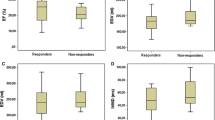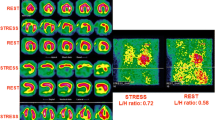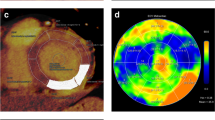Abstract
Background
We used beta-methyl iodophenyl pentadecanoic acid (BMIPP) single photon emission computed tomography (SPECT) to evaluate fatty acid metabolism in patients who were candidates for permanent pacemaker implantation and in patients with atrioventricular (AV) synchronous pacing.
Methods and Results
We performed BMIPP SPECT studies in 66 patients with bradyarrhythmia, of whom 11 patients were candidates for permanent pacemaker implantation, 27 patients had atrial pacing (atrial sensing, inhibited mode, simple programmable [AAI]), and 28 patients had atrial synchronous ventricular inhibited pacing (ventricular pacing, 2-chamber sensing, atrial-triggered and ventricular-inhibited, multiprogrammable [VDD]) or atrial and ventricular pacing in sequence (atrial and ventricular sensing, atrial-inhibited and atrial-triggered, ventricular-inhibited, multiprogrammable [DDD]). A qualitative assessment revealed that the BMIPP uptake at the septal, inferior, and apical regions was significantly decreased in the patients with VDD/DDD compared with both the candidates for permanent pacemaker implantation and the patients with AAI. The total extent score (ES) and severity score (SS) were significantly higher in the patients with VDD/DDD than in the other 2 groups. Significant regional differences of both ES and SS values were observed at the septal and inferior regions in the patients with VDD/DDD compared with the other groups. No differences were found between the qualitative and quantitative measures of BMIPP uptake in the candidates for permanent pacemaker implantation and those in the patients with AAI.
Conclusion
Our study suggests that AV synchronous right ventricular pacing resulting in the delayed conduction and depolarization of myocardial cells may directly interfere with regional cellular free fatty acid uptake and metabolism.
Similar content being viewed by others
References
Parsonnet V, Furman S, Smyth NPD, Bilitch M. Optimal resources for implantable cardiac pacemakers: pacemaker study group. Circulation 1983;68:227–44.
Parsonnet V, Bernstein AD. Cardiac pacing in the 1980s: treatment and techniques in transition. J Am Coll Cardiol 1983;1:339–54.
Haas JM, Strait GB. Pacemaker-induced cardiovascular failure: hemodynamic and angiographic observations. Am J Cardiol 1974;33:295–9.
Herbert WH. Left bundle branch block and coronary artery disease. J Electrocardiol 1975;8:317–24.
Schneider JF, Thomas HE Jr, Sorlie P, Kreger BE, McNamara PM, Kannel WB. Comparative features of newly acquired left and right bundle branch block in the general population: the Framingham study. Am J Cardiol 1981;47:931–40.
Rothbart RM, Beller GA, Watson DD, Nygaard TW, Gibson RS. Diagnostic accuracy and prognostic significance of quantitative thallium-201 scintigraphy in patients with left bundle branch block. Am J Noninvas Cardiol 1987;1:197–205.
Lebtahi NE, Stauffer JC, Delaloye AB. Left bundle branch block and coronary artery disease: accuracy of dipyridamole thallium-201 single-photon emission computed tomography in patients with exercise anteroseptal perfusion defects. J Nucl Cardiol 1997;4:266–73.
O'Keefe JH, Bateman TM, Barnhart CS. Adenosine thallium-201 is superior to exercise thallium-201 for detecting coronary artery disease in patients with left bundle branch block. J Am Coll Cardiol 1993;21:1332–8.
Tse HF, Lau CP. Long-term effect of right ventricular pacing on myocardial perfusion and function. J Am Coll Cardiol 1997;29:744–9.
Ono S, Nohara R, Kambara H, Okuda K, Kawai C. Regional myocardial perfusion and glucose metabolism in experimental left bundle branch block. Circulation 1992;85:1125–31.
Altehoefer C, Dahl JV, Buell U. Septal glucose metabolism in patients with coronary artery disease and left bundle-branch block. Coron Artery Dis 1993;4:569–72.
Opie LH. Metabolism of the heart in health and disease. Part 1. Am Heart J 1968;76:685–98.
Opie LH. Effects of regional ischemia on metabolism of glucose and fatty acid: relative rates of aerobic and anaerobic energy production during myocardial infarction and comparison with effects of anoxia. Circ Res 1976;38:52–74.
Sochor H, Schelbert HR, Schwaiger M, Henze E, Phelps ME. Studies of fatty acid metabolism with positron emission tomography in patients with cardiomyopathy. Eur J Nucl Med 1986;12:66–9.
Tamaki N, Kawamoto M, Yonekura Y, Fujibayashi Y, Takahashi N, Konishi J, et al. Regional metabolic abnormality in relation to perfusion and wall motion in patients with myocardial infarction: assessment with emission tomography using an iodinated branched fatty acid analog. J Nucl Med 1992;33:659–67.
Hashimoto A, Nakata T, Tsuchihashi K, Tanaka S, Fujimori K, Iimura O. Postischemic functional recovery and BMIPP uptake after primary percutaneous transluminal coronary angioplasty in acute myocardial infarction. Am J Cardiol 1996;77:25–30.
Kurata C, Tawarahara K, Taguchi T, Aoshima S, Kobayashi A, Yamazaki N, et al. Myocardial emission computed tomography with iodine-123-labeled beta-methyl-branched fatty acid in patients with hypertrophic cardiomyopathy. J Nucl Med 1992;33:6–13.
Knapp FF Jr, Ambrose KR, Goodman MM. New radioiodinated methyl-branched fatty acids for cardiac studies. Eur J Nucl Med 1986;12:39–44.
Garcia EV, Train KV, Maddahi J, Prigent F, Friedman J, Areeda J, et al. Quantification of rotational thallium-201 myocardial tomography. J Nucl Med 1985;26:17–26.
Stirner H, Bull U, Kleinhans E. Three-dimensional ROI-based quantification of stress/rest 201Tl myocardial SPECT: presentation of method. Nucl Med 1986;25:128–33.
Sakata K, Miura F, Sugino H, Saegusa T, Shirotani M, Yoshida H, et al. Assessment of regional sympathetic nerve activity in vasospastic angina: analysis of 123-labeled metaiodobenzylguanidine scintigraphy. Am Heart J 1997;133:484–9.
McGowan RL, Welch TG, Zaret BL, Bryson AL, Martin ND, Flamm MD. Noninvasive myocardial imaging with potassium-43 and rubidium-81 in patients with left bundle branch block. Am J Cardiol 1976;38:422–8.
Hirzel HO, Senn M, Nuesch K, Buettner C, Pfeiffer A, Hess OM, et al. Thallium-201 scintigraphy in complete left bundle branch block. Am J Cardiol 1984;53:764–9.
Depuey EG, Guertler-Krawczynska E, Robbins WL. Thallium-201 SPECT in coronary artery disease patients with left bundle branch block. J Nucl Med 1988;29:1479–85.
Burns RJ, Galligan L, Wright LM, Lawand S, Burke RJ, Gladstone PJ. Improved specificity of myocardial thallium-201 single-photon emission computed tomography in patients with left bundle branch block by dipyridamole. Am J Cardiol 1991;68:504–8.
Knapp WH, Bentrup A, Schmidt U, Ohlmeier H. Myocardial scintigraphy with thallium-201 and technetium-99m-hexakis-methoxy-isobutylisonitrile in left bundle branch block: a study in patients with and without coronary artery disease. Eur J Nucl Med 1993;20:219–24.
Vaduganathan P, He ZX, Raghavan C, Mahmarian JJ, Verani MS. Detection of left anterior descending coronary artery stenosis in patients with left bundle branch block: exercise, adenosine, dobutamine imaging? J Am Coll Cardiol 1996;28:543–50.
James TN. Pathology of small coronary arteries. Am J Cardiol 1967;20:679–91.
Sugiura M, Hiraoka K, Ohkawa S, Ueda K, Toku A. A clinicopathological study on 25 cases of complete left bundle branch block. Jap Heart J 1979;20:163–76.
Jazmati B, Sadaniantz A, Emaus SP, Heller GV. Exercise thallium-201 imaging in complete left bundle branch block and the prevalence of septal perfusion defects. Am J Cardiol 1991;67:46–9.
Sugihara H, Tamaki N, Nozawa M, Ohmura T, Inamoto Y, Taniguchi Y, et al. Septal perfusion and wall thickening in patients with left bundle branch block assessed by technetium-99m-sestamibi gated tomography. J Nucl Med 1997;38:545–7.
Lee MA, Dae MW, Langberg JJ, Griffin JC, Chin MC, Finkbeiner WE, et al. Effects of long-term right ventricular apical pacing on left ventricular perfusion, innervation, function and histology. J Am Coll Cardiol 1994;24:225–32.
Prinzen FW, Augustijn CH, Arts T, Allessie MA, Reneman RS. Redistribution of myocardial fiber strain and blood flow by asynchronous activation. Am J Physiol 1990;259:300–8.
Delhaas T, Arts T, Prinzen FW, Reneman RS. Regional fibre stress-fibre strain area as an estimate of regional blood flow and oxygen demand in the canine heart. J Physiol (Lond) 1994;477:481–96.
Lakkis NM, He ZX, Verani MS. Diagnosis of coronary artery disease by exercise thallium-201 tomography in patients with a right ventricular pacemaker. J Am Coll Cardiol 1997;29:1221–5.
Sugihara H, Otsuki K, Taniguchi Y, Ito K, Ushizima Y, Nakagawa M, et al. Assessment of septal perfusion and fatty acid metabolism in patients with complete left bundle branch block [abstract]. Eur J Nucl Med 1994;21S:171.
Altehoefer C, Dahl JV, Bares R, Stocklin GL, Bull U. Metabolic mismatch of septal beta-oxidation and glucose utilization in left bundle branch block assessed with PET. J Nucl Med 1995;36:2056–9.
Yamamichi Y, Kusuoka H, Morishita K, Shirakami Y, Kurami M, Okano K, et al. Metabolism of iodine-123-BMIPP in perfused rat hearts. J Nucl Med 1995;36:1043–50.
Fujibayashi Y, Nohara R, Hosokawa R, Okuda K, Yonekura Y, Tamaki N, et al. Metabolism and kinetics of iodine-123-BMIPP in canine myocardium. J Nucl Med 1996;37:757–61.
Author information
Authors and Affiliations
Rights and permissions
About this article
Cite this article
Yoshida, H., Shirotani, M., Mochizuki, M. et al. Assessment of myocardial fatty acid metabolism in atrioventricular synchronous pacing: Analysis of iodine 123-labeled beta-methyl iodophenyl pentadecanoic acid SPECT. J Nucl Cardiol 6, 33–40 (1999). https://doi.org/10.1016/S1071-3581(99)90063-6
Received:
Accepted:
Issue Date:
DOI: https://doi.org/10.1016/S1071-3581(99)90063-6




